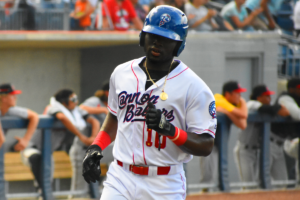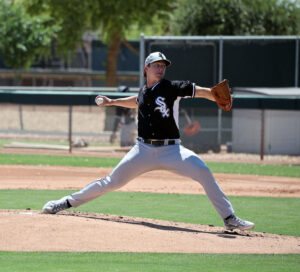Catching Up with the Kannapolis Backstops
Since A.J. Pierzynski left the team in 2012, the catching position has been a revolving door for the White Sox. And had A.J. not have been a locker room problem at his previous stops they probably would not have had a chance to acquire him. If you’re old enough to remember the last time the White Sox developed a catching prospect you’re probably at the point in your life where you try not to disclose your age unless you’re looking to qualify for an AARP discount.
The Sox have some intriguing prospects at Triple-A and Double-A that are expected to become major league-level talents sooner than later. But if White Sox fans have learned anything in 2018, it’s the importance of organizational depth. Let’s take a look at a few of those depth pieces currently putting on the catching gear for Class-A Kannapolis, who somewhat unusually are carrying three of them on their roster.
Carlos Perez

This 21-year-old out of Venezuela is hitting .281 in 67 games in his first full season at Kannapolis. While his overall numbers don’t jump out at you (.281/.293/.368 for a .661 OPS), he has been extremely productive the last month or so, posting an impressive slash line of .403/.411/.528 with a stellar .939 ops in July. He also clubbed his only home run of the season. It’ll be interesting to see if something has clicked and the upward offensive trajectory continues. One thing he’s done extremely well at every stop and continues to, is make consistent contact. So far this year while playing slightly younger than league average, he’s struck out just 26 times in 240 PA (10.8%), and for his entire minor league career he’s struck out just 50 times in 781 PA (that’s a ridiculous 6.4% K-rate).
In an interview, through translator Luis Curbelo (thanks Luis!), Perez stated that one of his goals for this year is to hit .300. With a couple more weeks left to go in the season, this is within reach, particularly if he can maintain the torrid pace he set in July. He attributes his recent success to the hard work he’s put in at the dish. He hasn’t made any significant changes to his approach, despite his early season struggles.
Defensively, he’s gunned down 36% of would-be base stealers, while committing four errors and allowing 11 passed balls. Through Curbelo, Perez stated that he places more emphasis on developing defensively than he does with the bat. He feels that the catching position is the captain of the defense and to not perform well will be letting down the entire team. He is responsible for calling pitches and takes note of the hitters’ approach to a certain offering. He relies on the coaching staff whenever he’s in doubt.
Signed in 2014 out of Venezuela, the 5’10”, 160 pounder was known as a contact hitter not expected to have much power due to his small size. He recognizes this deficiency and cited it has an area he is targeting for improvement. In addition to the White Sox coaching staff, he’s got the support system in place to achieve this. He’s got two brothers in the minors, whom he talks to on a daily basis. Their primary advice is to work hard and treat every day like it could be your last.
Despite being in the White Sox organization for four years and the presence of his brothers, Perez is still adjusting to life in the USA. The food and the climate are the primary things he finds challenging. He enjoys coming to the park every day, the fan support and appreciates the opportunity he’s been given. He’s planning to go back home to Venezuela in the offseason, and in addition to spending time with his family he’s going to work on developing his entire game.
Evan Skoug

The 22-year-old out of Texas Christian by way of Libertyville, Illinois, was generating some buzz as a prospect during the offseason, hovering on the periphery of our Top 30 list and making the back end of some others.
He has struggled at the dish in his first full season in Class-A, posting a slash line of .194/.288/.308 and a 34% strikeout rate. Skoug acknowledges that he hasn’t performed up to his standards with the bat:
“But the positive I can take out of it is that I’m learning how to grind through the struggle. Especially with the success so many of our guys have had this season, but I’m learning not to let it affect my attitude,” said Skoug in a phone interview.
To bust the slump, he’s focusing on the mental side of the equation, meeting with the team psychologist as well as his personal sports psychologist. He’s also talked to former players. He tries to take every game as a new season and forget what happened the day before. With a pedigree for generating power from the left side of the plate, he has blasted five home runs and 12 extra base hits in 253 at-bats this season providing a glimpse as to why he is considered a prospect with big upside.
Skoug mentioned the consistency of pitchers and playing every day as the biggest difference between pro and college ball. Despite logging 442 innings behind the plate, he still feels fresh at this point of the season, noting the three-man rotation that Kannapolis uses and the training staff for getting him through the 143 game schedule. He likes the competition that the three-man rotation generates, while it also gives him a chance to learn by watching others.
Coming out of TCU, defense was considered the weaker aspect of Evan’s game, but he has eliminated 22 base stealers while committing one error with eight passed balls in 53 starts behind the dish. Like Perez, he feels that defense is the more important developmental aspect of his game:
“There’s so much more to it than catching it and throwing it. You have to deal with different pitchers and how they respond to certain situations. You have to earn their respect as well as catch it, block it and throw it.”
Evan feels that defense is his key to getting to the majors. In addition to learning the individual pitchers’ strengths, weaknesses, and preferences, he cited communicating with Spanish speaking players as another hurdle in calling a game. He feels that he improved defensively over the course of the season. He’s gotten compliments from coaches and players alike about what he’s done behind the dish, reinforcing that notion.
The Chicago suburban native plans to head to Fort Worth and work out at TCU in the offseason. His primary objectives will be to get in better shape and learn more about his swing. He’ll also be at Instructs in a month or so. “I plan to take a couple weeks off after Instructs and then get in as much work as I can until spring training rolls around.” Here’s some video of Skoug’s swing, from the open side to see the mechanics, as it stands in 2018:
Given what Skoug was able to accomplish at TCU – amongst the Big 12 leaders in most offensive categories – it’s a fair bet he’ll turn it around offensively. The scouting report from Baseball America entering the draft cited his short stroke that generates power to all fields as his primary asset. It also noted that he could be a candidate for a position switch. The metrics and his own comments don’t point to a glaring deficiency in that area. Perhaps the improvement he has made defensively will enable him to better focus offensively and morph into the left-handed power hitter he was projected to be coming out of the draft. There’s no rush at this point.
Michael Hickman

Another left-handed bat from the catcher’s spot, Hickman has had some challenges on offense as well. His slash line of .207/.270/.276 is a drop-off from his 2017 performance at AZL. He’s shown a penchant for driving the ball, with 13 of his 48 hits going for extra bases, including a game-tying, 2-out 2-run double in the bottom of the ninth on August 15. He’s also struggled to make contact, striking out at a 31% clip. Like Skoug, left-handed bats with the ability to drive the ball, play well at the MLB level, so he’ll be given time to see if he can harness that power on a more consistent basis. He’s also 21 and the youngest of the catching trio for the Intimidators.
Selected in the 13th round of the 2016 draft (after the Sox also drafted him the previous year in the 36th round), the 6’1″, 215 pounder has been splitting time at catcher and first base, while also getting some further at-bats as the DH. He’s logged 224 innings behind the plate over the course of 26 starts and added 15 more starts at first base. Behind the plate, he’s throwing out base runners at a 31% rate while committing four errors to go with six passed balls. As a first baseman, he’s committed four errors, but that’s not his native role. In a phone interview, Hickman indicated he’s spent more time focusing on his defense at catcher while still taking ground balls at first base. He’s more comfortable behind the plate having played the position as an amateur. He learning first base and gaining more confidence the more innings he logs.
In addition to developing on the field, Hickman is getting on-the-job training at going over scouting reports on hitters before the game, making in-game adjustments and learning the pitching staff. This is typically done via bullpen sessions when he’s not in the lineup. He spends time going over the various pitchers’ offerings and preferences. He’s also responsible for calling pitches during the games. “Behind the dish, I’m working on commanding the field a little more. And also working with the pitchers,” said Hickman via phone interview.
Juggling two positions, particularly one as challenging as catcher, while trying to produce offensively can be challenging but Hickman feels he’s improved defensively at both positions this season. He acknowledges that he has had a difficult time at the plate, especially in the second half of the season. “I’ve been having more trouble with off-speed pitches and not trying too do to much,” said Hickman. He’s seeing a lot more off-speed pitches with Kannapolis that he did last year in Arizona, accounting for the drop-off offensively.
Coming into the draft, the native of Katy, Texas was called a talked up as a potential 2015 1st rounder by Bleacher Report. They cited his huge power potential as the primary force behind the lofty prognostication. They also noted his solid defense as a receiver but mentioned a position switch could be in the offing. As he is currently toggling between two positions, one with much less responsibility (first base), it’ll be interesting to see if the organization determines if he’ll better off focusing on developing his substantial upside with the bat rather than mastering the defensive rigors required for an MLB level backstop.
Here are a pair of videos to give you a feel for where that raw power comes from (open side, then behind home plate):
Hickman plans to spend the offseason training at a baseball-dedicated facility, where he’ll focus on developing more speed and strength. He’ll also put in time on his swing with the goal of getting it more consistent. He’ll be in contact with the team as well, just as the rest of the prospects.
Want to know right away when we publish a new article? Type your email address in the box on the right-side bar (or at the bottom, if on a mobile device) and click the “create subscription” button. Our list is completely spam free, and you can opt out at any time.






